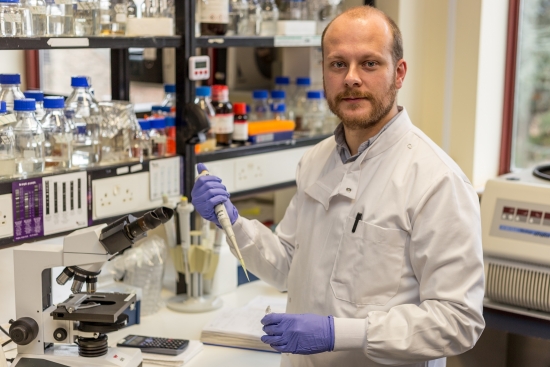By Dr Lisa Smith, senior lecturer in criminology, University of Leicester and Professor Mark Jobling, professor of genetics, University of Leicester.
Listen to Sir Alec Jeffreys being interviewed by Professor Alison Woollard FRSB at the RSB’s fundraising event in May 2016.
 Today, thanks partly to TV’s CSI franchise, everyone is familiar with the DNA profile – super-sensitive, and individually unique. But go back 40 years, and DNA-based forensic analysis did not exist. Instead, there was an industry that analysed not DNA itself, but its products – proteins. It started in 1900 with the discovery, by Karl Landsteiner, of the ABO blood group. He realised that this system could exclude a suspect from depositing a blood-stain at a crime-scene. Given the small number of different types, the average power of exclusion was low, but this increased once enzyme variants in blood were included. Because each variant is inherited independently, the frequencies of types (alleles) for each system could be multiplied, increasing discrimination. Read more
Today, thanks partly to TV’s CSI franchise, everyone is familiar with the DNA profile – super-sensitive, and individually unique. But go back 40 years, and DNA-based forensic analysis did not exist. Instead, there was an industry that analysed not DNA itself, but its products – proteins. It started in 1900 with the discovery, by Karl Landsteiner, of the ABO blood group. He realised that this system could exclude a suspect from depositing a blood-stain at a crime-scene. Given the small number of different types, the average power of exclusion was low, but this increased once enzyme variants in blood were included. Because each variant is inherited independently, the frequencies of types (alleles) for each system could be multiplied, increasing discrimination. Read more


 Being selected to present
Being selected to present  By Melanie Smallman, deputy director, UCL Responsible Research Innovation Hub
By Melanie Smallman, deputy director, UCL Responsible Research Innovation Hub My heart was split between arts and sciences for a long time until I was choosing my A-levels I realised that they can be combined in many ways. One of these ways is wildlife and nature photography. I love this area of photography because I love biology and it enables you to explore and learn about the creatures of the world without leaving your home. Our environment is constantly changing and photography also gives you the chance to capture moments that will never be repeated.
My heart was split between arts and sciences for a long time until I was choosing my A-levels I realised that they can be combined in many ways. One of these ways is wildlife and nature photography. I love this area of photography because I love biology and it enables you to explore and learn about the creatures of the world without leaving your home. Our environment is constantly changing and photography also gives you the chance to capture moments that will never be repeated.  By Davide Gaglio, amateur photographer and student at the Percy FitzPatrick Institute of African Ornithology
By Davide Gaglio, amateur photographer and student at the Percy FitzPatrick Institute of African Ornithology The presence of plastics, particularly microplastics, in the environment has received increasing attention in recent years, with the UK government launching
The presence of plastics, particularly microplastics, in the environment has received increasing attention in recent years, with the UK government launching  Has anyone ever told you that you have a distinct walk? Or that they can recognise you by your stride? Well that can actually be quantified and measured in your shoeprint.
Has anyone ever told you that you have a distinct walk? Or that they can recognise you by your stride? Well that can actually be quantified and measured in your shoeprint. I recently attended the
I recently attended the  Coming from a small village in Portugal and wanting to become a microbiologist at a young age, I really longed for an opportunity to meet a scientist and find out more about the profession.
Coming from a small village in Portugal and wanting to become a microbiologist at a young age, I really longed for an opportunity to meet a scientist and find out more about the profession.